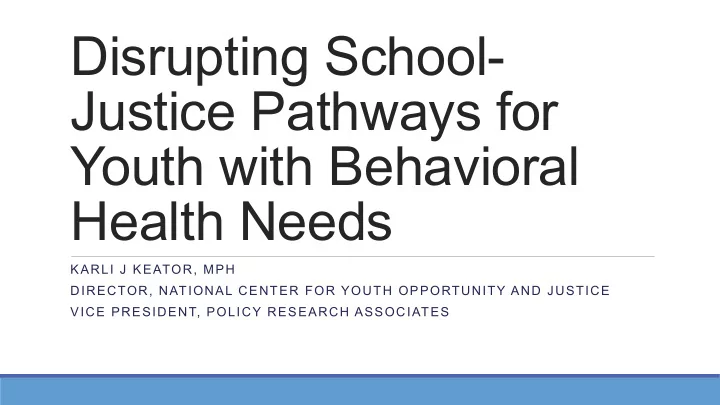

Disrupting School- Justice Pathways for Youth with Behavioral Health Needs KARLI J KEATOR, MPH DIRECTOR, NATIONAL CENTER FOR YOUTH OPPORTUNITY AND JUSTICE VICE PRESIDENT, POLICY RESEARCH ASSOCIATES
Prevalence of Behavioral Health Conditions Among Justice- Involved Youth
Consequences of Unmet Need A steady and often rapid decline in mental health and increased risk for: ◦ substance use and abuse ◦ suicide ◦ challenges at home, in school, or at work ◦ homelessness ◦ victimization ◦ chronic physical health problems More than half do not receive behavioral health treatment services
Youth with Behavioral Health Needs Overrepresented on School-Justice Pathway
Youth with Behavioral Health Needs Overrepresented on School-Justice Pathway
Example: The School Responder Model (SRM) Mental Health/Juvenile Justice Action Network (2007-2011) ◦ CT , CO, IL, LA, OH , PA, TX, WA ◦ Major issue: Keep youth with behavioral health needs out of the juvenile justice system when appropriate Expansion Sites (2012-now) ◦ LA, MI, MN, NV, NY, SC, WI , WV 6
A School Responder Model… A School Responder Model . . . Identifies Connects Restores
SRM Outcomes Connecticut – School-Based Diversion Initiative ◦ 34% reduction in court referrals ◦ 47% more students connected to behavioral health services ◦ 4300+ teachers and staff have been trained to recognize trauma and mental health concerns Nevada ◦ 15% reduction in referrals to probation ReNew Accelerated High School, Louisiana ◦ 49% decrease in suspensions in the 2018-2019 school year compared to the previous year Schenectady High School, New York ◦ 70% reduction in superintendent hearings in 2017-2018 compared to the previous year 8
Traditional Response Model
SRM Model
What It Takes . . . Cross-Systems Behavioral Collaborative Health Team Response Family and Creation of Youth Formal Engagement Structures
Cross-Systems Support School Leadership Law Enforcement Community Behavioral Health Families and Youth 12
An SRM’s likelihood of success Engaging increases when: Families ◦ Lived experience informs program design ◦ Caregivers participate and Youth ◦ Consent is part of the model ◦ Youth buy into the model Many of the evidence-based practices shown to be effective at preventing or reducing delinquency require active engagement of youth in the context of their families. 13
Family Engagement and Schools Math proficiency Increased test Academic Higher graduation and reading scores perseverance rates performance Improved Improved school Improved social Less likely to be Homework behavior skills suspended completion levels School readiness Consistent attendance Family engagement 14
Implementing a Behavioral Health Response Youth who are in need of Risk factors school-based behavioral health diversion have two key Escalating behaviors characteristics: ◦ Indicators of potential need for Arrest likely behavioral health supports ◦ At risk of referral to the juvenile Youth in justice system for school juvenile justice system behaviors 15
Implementing a Behavioral Health Response Identification begins with recognizing signs and symptoms and screening Screening tools should be: ◦ Short/brief ◦ Not individualized ◦ Easy to administer ◦ Easy to score ◦ Targeted to critical issues 16
17
Implementing a Behavioral Health Response A behavioral health response includes connecting youth who “screen in” with appropriate and accessible behavioral service providers ◦ Intentional Pathways to Services ◦ Resource Mapping Behavioral health services are health services 18
Connecting with Existing Resources • Early and Periodic Screening, Diagnostic and Treatment (EPSDT) entitlement (Medicaid) • School-based health centers or mental health workers • Community-partnered behavioral health in schools • Mobile mental health crisis services for kids • Partnerships with local behavioral health clinics In Connecticut, partnerships with Mobile Crisis Intervention Services offer free behavioral health services when a youth is experiencing difficulties. 19
Create Formal Structures Responder initiatives must be institutionalized through formal structures that will endure and preserve objectivity through changes in leadership and staff turnover Key structures include: ◦ Training and professional development ◦ Policies and procedures ◦ Memorandums of understanding (MOUs) ◦ Structured decision-making tools 20
What Can State Policymakers Do? • Reduce barriers to alternative response models • Support cross-systems training • Formalize data and information-sharing across systems • Sustain and expand existing resources • Leverage federal funding or waivers to create necessary resources
Summary 1. Many students have undiagnosed, untreated, or undertreated behavioral health conditions that affect their school performance and behavior 2. Traditional school discipline policies have the unintended consequence of creating school-justice pathways for many students with behavioral health needs 3. There are alternative response models with demonstrated effectiveness for reducing school-justice pathways and maintaining school safety 4. Behavioral health conditions among youth are often not identified because professionals working across service sectors are not adequately trained to recognize and respond to the signs and symptoms of these conditions 5. Youth and family engagement are critical to the success of school-based diversion initiatives
Recommend
More recommend